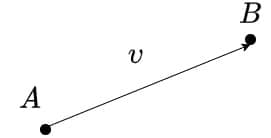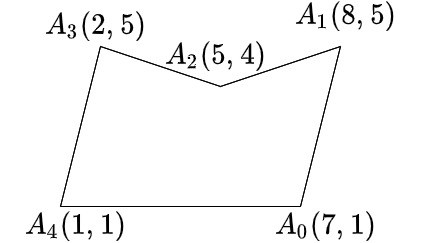1. 概述
二维多边形面积的计算是图形学、GIS、物理模拟等多个领域中的常见需求。虽然数学上已有多种方法可以计算规则多边形的面积,但对于任意形状的非规则多边形,计算则相对复杂。
本文将介绍一种基于线性代数的基本运算(向量和行列式)来计算任意二维多边形面积的方法。该方法无需三角函数或平方根运算,计算效率高,适合在程序中实现。
2. 基本概念与运算
要理解多边形面积的计算原理,需要掌握以下两个基础概念:
2.1 向量
二维空间中的向量可以用一个有序对表示,如:
$$
\vec{v} = (x_2 - x_1, y_2 - y_1)
$$
它表示从点 $ A(x_1, y_1) $ 到点 $ B(x_2, y_2) $ 的位移。

2.2 矩阵与行列式
一个 $ 2 \times 2 $ 矩阵的行列式定义如下:
$$ \begin{vmatrix}a&b\c&d\end{vmatrix} = a \times d - b \times c $$
行列式的值可以用来表示向量所围成的平行四边形面积,也可以用于判断向量方向(正负面积)。
3. 三角形与平行四边形的面积计算
3.1 平行四边形面积
两个向量 $ \vec{v} $ 和 $ \vec{w} $ 所围成的平行四边形面积等于这两个向量构成的矩阵的行列式绝对值:
$$ S_{\text{parallelogram}} = |\vec{v} \times \vec{w}| $$
3.2 三角形面积
三角形面积为平行四边形面积的一半:
$$ S_{\text{triangle}} = \frac{1}{2} \cdot |\vec{v} \times \vec{w}| $$
例如,三角形 ABC 的面积可表示为:
$$ S_{ABC} = \frac{1}{2} \cdot |(B - A) \times (C - A)| $$
✅ 优点:不需要计算角度或长度,仅需坐标即可快速计算。
❌ 注意:向量顺序会影响面积的正负,逆时针为正,顺时针为负。
4. 多边形面积计算原理
4.1 基本思想
任意简单多边形(无自交)都可以被分解为若干个三角形。我们可以将所有三角形的有符号面积相加,从而得到整个多边形的面积。
设点 $ P $ 为任意参考点(通常选原点),多边形顶点为 $ A_0, A_1, ..., A_{n-1} $,其中 $ A_n = A_0 $,则多边形面积为:
$$ S_{\text{polygon}} = \frac{1}{2} \sum_{i=0}^{n-1} (x_i y_{i+1} - y_i x_{i+1}) $$
4.2 原理说明
将多边形分解为以点 $ P $ 为公共顶点的多个三角形:
$$ \triangle P A_0 A_1,\ \triangle P A_1 A_2,\ \dots,\ \triangle P A_{n-1} A_0 $$
这些三角形中,部分面积为正(逆时针方向),部分为负(顺时针方向),最终相加时会自动抵消掉不属于多边形的区域。
4.3 最终公式
设顶点坐标为 $ (x_0, y_0), (x_1, y_1), ..., (x_{n-1}, y_{n-1}) $,则:
$$ S_{\text{polygon}} = \frac{1}{2} \left| \sum_{i=0}^{n-1} (x_i y_{i+1} - y_i x_{i+1}) \right| $$
其中 $ x_n = x_0, y_n = y_0 $。
5. 数学证明:Green 公式法
使用 Green 公式,可以将多边形面积转化为沿边界积分的形式:
$$ A = \iint_D dA = \oint_C x,dy $$
将每条边参数化后代入积分,最终推导出与上述公式一致的结果:
$$ A = \frac{1}{2} \sum_{i=0}^{n-1} (x_i y_{i+1} - y_i x_{i+1}) $$
这说明我们前面的公式不仅直观,而且有坚实的数学基础。
6. 示例:多边形面积计算
考虑以下五边形:

顶点依次为:
- $ A_0 = (7, 1) $
- $ A_1 = (8, 5) $
- $ A_2 = (5, 4) $
- $ A_3 = (2, 5) $
- $ A_4 = (1, 1) $
带入公式:
$$ S = \frac{1}{2} \left( (7 \cdot 5 - 1 \cdot 8) + (8 \cdot 4 - 5 \cdot 5) + (5 \cdot 5 - 4 \cdot 2) + (2 \cdot 1 - 5 \cdot 1) + (1 \cdot 1 - 1 \cdot 7) \right) $$
$$ S = \frac{1}{2} (35 - 8 + 32 - 25 + 25 - 8 + 2 - 5 + 1 - 7) = \frac{42}{2} = 21 $$
✅ 结果:该五边形面积为 21。
7. 总结
本文介绍了如何利用向量叉积和行列式快速计算任意二维多边形的面积。该方法基于线性代数和 Green 公式,具有以下特点:
- ✅ 无需三角函数或根号运算,效率高
- ✅ 支持任意形状的简单多边形
- ✅ 可以判断顶点顺序(顺时针或逆时针)
该方法在实际开发中非常实用,尤其适用于图形处理、游戏开发、地理信息系统(GIS)等领域。